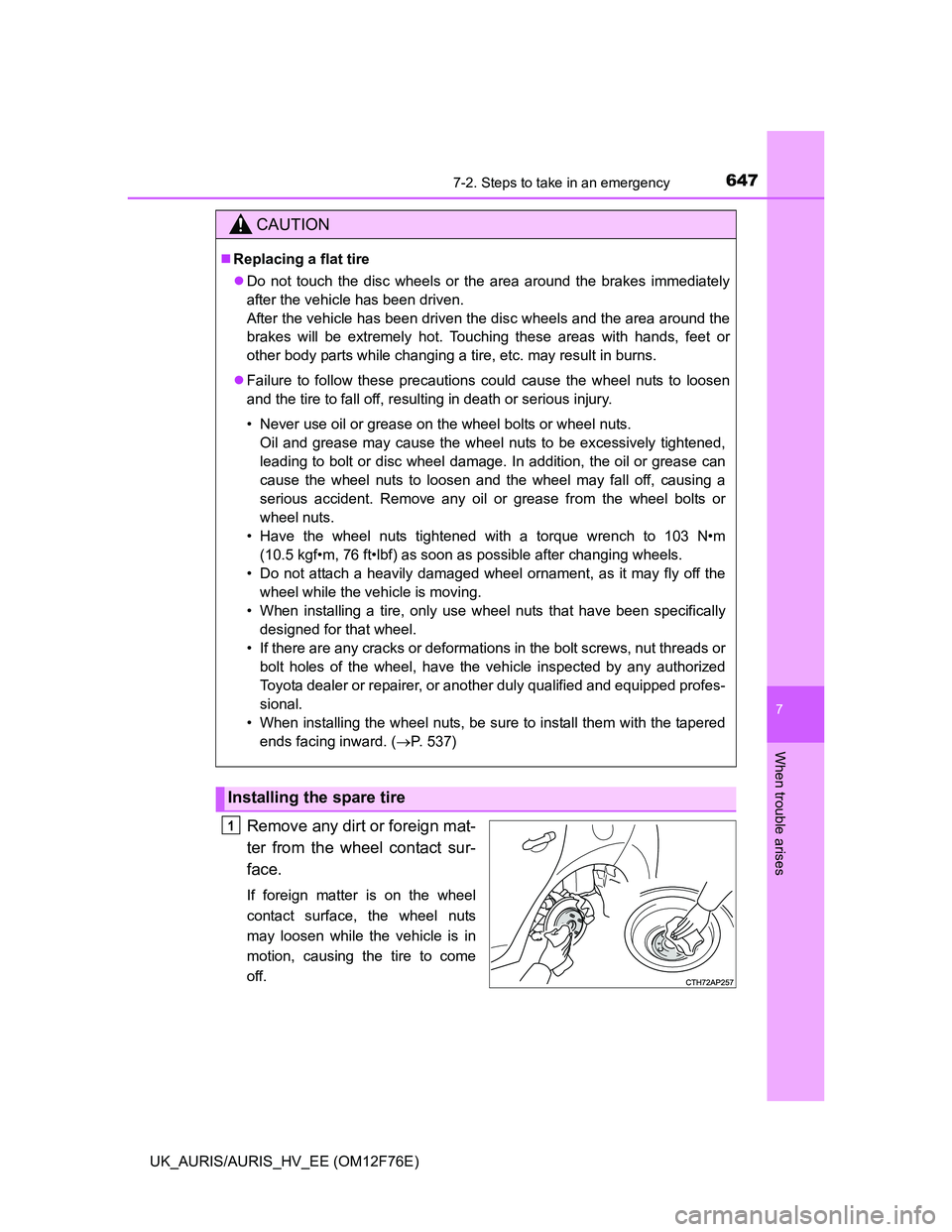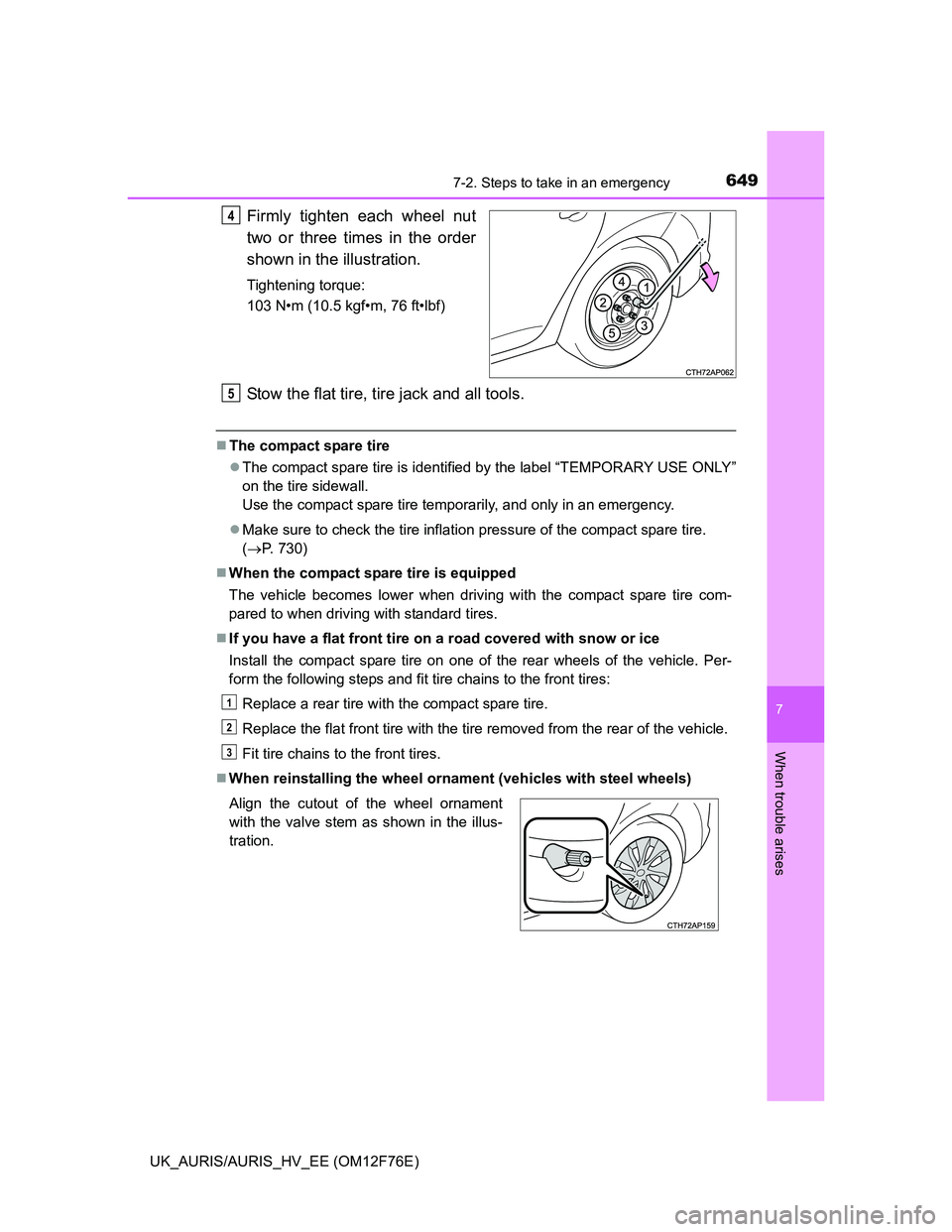Page 239 of 768

2394-1. Before driving
UK_AURIS/AURIS_HV_EE (OM12F76E)
4
Driving
NOTICE
When driving the vehicle (vehicles with a manual transmission)
Do not depress the accelerator and brake pedals at the same time during
driving, as this may restrain driving torque.
Do not shift gears unless the clutch pedal is fully depressed. After shifting,
do not release the clutch pedal abruptly. Doing so may damage the clutch,
transmission and gears.
Observe the following to prevent the clutch from being damaged.
• Do not rest your foot on the clutch pedal while driving.
Doing so may cause clutch trouble.
• Do not use any gear other than the 1st gear when starting off and mov-
ing forward.
Doing so may damage the clutch.
• Do not use the clutch to hold the vehicle when stopping on an uphill
grade.
Doing so may damage the clutch.
Do not shift the shift lever to R when the vehicle is still moving. Doing so
may damage the clutch, transmission and gears.
When parking the vehicle (vehicles with a Multidrive)
Always shift the shift lever to P. Failure to do so may cause the vehicle to
move or the vehicle may accelerate suddenly if the accelerator pedal is
accidentally depressed.
Avoiding damage to vehicle parts
Do not turn the steering wheel fully in either direction and hold it there for
an extended period of time.
Doing so may damage the power steering motor.
When driving over bumps in the road, drive as slowly as possible to avoid
damaging the wheels, underside of the vehicle, etc.
Diesel model: Make sure to idle the engine immediately after high-speed
driving or hill climbing. Stop the engine only after the turbocharger has
cooled down.
Failure to do so may cause damage to the turbocharger.
Page 647 of 768

6477-2. Steps to take in an emergency
UK_AURIS/AURIS_HV_EE (OM12F76E)
7
When trouble arises
Remove any dirt or foreign mat-
ter from the wheel contact sur-
face.
If foreign matter is on the wheel
contact surface, the wheel nuts
may loosen while the vehicle is in
motion, causing the tire to come
off.
CAUTION
Replacing a flat tire
Do not touch the disc wheels or the area around the brakes immediately
after the vehicle has been driven.
After the vehicle has been driven the disc wheels and the area around the
brakes will be extremely hot. Touching these areas with hands, feet or
other body parts while changing a tire, etc. may result in burns.
Failure to follow these precautions could cause the wheel nuts to loosen
and the tire to fall off, resulting in death or serious injury.
• Never use oil or grease on the wheel bolts or wheel nuts.
Oil and grease may cause the wheel nuts to be excessively tightened,
leading to bolt or disc wheel damage. In addition, the oil or grease can
cause the wheel nuts to loosen and the wheel may fall off, causing a
serious accident. Remove any oil or grease from the wheel bolts or
wheel nuts.
• Have the wheel nuts tightened with a torque wrench to 103 N•m
(10.5 kgf•m, 76 ft•lbf) as soon as possible after changing wheels.
• Do not attach a heavily damaged wheel ornament, as it may fly off the
wheel while the vehicle is moving.
• When installing a tire, only use wheel nuts that have been specifically
designed for that wheel.
• If there are any cracks or deformations in the bolt screws, nut threads or
bolt holes of the wheel, have the vehicle inspected by any authorized
Toyota dealer or repairer, or another duly qualified and equipped profes-
sional.
• When installing the wheel nuts, be sure to install them with the tapered
ends facing inward. (P. 537)
Installing the spare tire
1
Page 649 of 768

6497-2. Steps to take in an emergency
UK_AURIS/AURIS_HV_EE (OM12F76E)
7
When trouble arises
Firmly tighten each wheel nut
two or three times in the order
shown in the illustration.
Tightening torque:
103 N•m (10.5 kgf•m, 76 ft•lbf)
Stow the flat tire, tire jack and all tools.
The compact spare tire
The compact spare tire is identified by the label “TEMPORARY USE ONLY”
on the tire sidewall.
Use the compact spare tire temporarily, and only in an emergency.
Make sure to check the tire inflation pressure of the compact spare tire.
(P. 730)
When the compact spare tire is equipped
The vehicle becomes lower when driving with the compact spare tire com-
pared to when driving with standard tires.
If you have a flat front tire on a road covered with snow or ice
Install the compact spare tire on one of the rear wheels of the vehicle. Per-
form the following steps and fit tire chains to the front tires:
Replace a rear tire with the compact spare tire.
Replace the flat front tire with the tire removed from the rear of the vehicle.
Fit tire chains to the front tires.
When reinstalling the wheel ornament (vehicles with steel wheels)
4
Align the cutout of the wheel ornament
with the valve stem as shown in the illus-
tration.
5
1
2
3
Page 730 of 768
7308-1. Specifications
UK_AURIS/AURIS_HV_EE (OM12F76E)
Ty p e A
*1: “For optimizing fuel economy, ECO tire pressure is recommended. Tire
pressure affects traveling comfort, road noise and steering characteristics.”
*2: Hybrid model (with ECO tire pressure label)
*3: 1ND-TV engine (with ECO tire pressure label)
Tires and wheels
Tire size195/65R15 91H
Tire inflation pres-
sure
(Recommended
cold tire inflation
pressure)
Vehicle speed
Front wheel
kPa (kgf/cm2
or bar, psi)
Rear wheel
kPa (kgf/cm2
or bar, psi)
More than 160
km/h (100 mph)260 (2.6, 38)260 (2.6, 38)
Normal pressure:
160 km/h (100
mph) or less
230 (2.3, 33)230 (2.3, 33)
ECO pressure*1:
160 km/h (100
mph) or less250 (2.5, 36)*2
260 (2.6, 38)*2
270 (2.7, 39)*3
250 (2.5, 36)*2
250 (2.5, 36)*2
260 (2.6, 38)*3
Wheel size15 6 J
Wheel nut torque103 N•m (10.5 kgf•m, 76 ft•lbf)
Page 731 of 768
7318-1. Specifications
UK_AURIS/AURIS_HV_EE (OM12F76E)
8
Vehicle specifications
Ty p e B
*1: “For optimizing fuel economy, ECO tire pressure is recommended. Tire
pressure affects traveling comfort, road noise and steering characteristics.”
*2: 1AD-FTV engine
*3: Hybrid model (with ECO tire pressure label)
Tire size205/55R16 91V
Tire inflation pres-
sure
(Recommended
cold tire inflation
pressure)
Vehicle speed
Front wheel
kPa (kgf/cm2
or bar, psi)
Rear wheel
kPa (kgf/cm2
or bar, psi)
More than 160
km/h (100 mph)270 (2.7, 39)*2
260 (2.6, 38)260 (2.6, 38)
Normal pressure:
160 km/h (100
mph) or less240 (2.4, 35)*2
230 (2.3, 33)230 (2.3, 33)
ECO pressure*1:
160 km/h (100
mph) or less
250 (2.5, 36)*3250 (2.5, 36)*3
Wheel size16 6 1/2 J
Wheel nut torque103 N•m (10.5 kgf•m, 76 ft•lbf)
Page 732 of 768
7328-1. Specifications
UK_AURIS/AURIS_HV_EE (OM12F76E)
Ty p e C
Ty p e D
*: 1AD-FTV engine
Tire size215/45R17 87W
Tire inflation pres-
sure
(Recommended
cold tire inflation
pressure)Vehicle speed
Front wheel
kPa (kgf/cm2
or bar, psi)
Rear wheel
kPa (kgf/cm2
or bar, psi)
More than 160
km/h (100 mph)260 (2.6, 38)260 (2.6, 38)
160 km/h (100
mph) or less230 (2.3, 33)230 (2.3, 33)
Wheel size17 7 J
Wheel nut torque103 N•m (10.5 kgf•m, 76 ft•lbf)
Tire size225/45R17 91W
Tire inflation pres-
sure
(Recommended
cold tire inflation
pressure)Vehicle speed
Front wheel
kPa (kgf/cm2
or bar, psi)
Rear wheel
kPa (kgf/cm2
or bar, psi)
More than 160
km/h (100 mph)270 (2.7, 39)*
260 (2.6, 38)260 (2.6, 38)
160 km/h (100
mph) or less240 (2.4, 35)*
230 (2.3, 33)230 (2.3, 33)
Wheel size17 7 J
Wheel nut torque103 N•m (10.5 kgf•m, 76 ft•lbf)
Page 733 of 768
7338-1. Specifications
UK_AURIS/AURIS_HV_EE (OM12F76E)
8
Vehicle specifications
Compact spare tire
When towing a trailer
Add 20.0 kPa (0.2 kgf/cm
2 or bar, 3 psi) to the recommended tire inflation
pressure and drive at speeds below 100 km/h (62 mph).
Tire sizeT125/70D17 98M
Tire inflation pressure
(Recommended cold
tire inflation pressure)
420 kPa (4.2 kgf/cm2 or bar, 60 psi)
Wheel size17 4T
Wheel nut torque103 N•m (10.5 kgf•m, 76 ft•lbf)